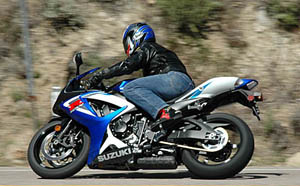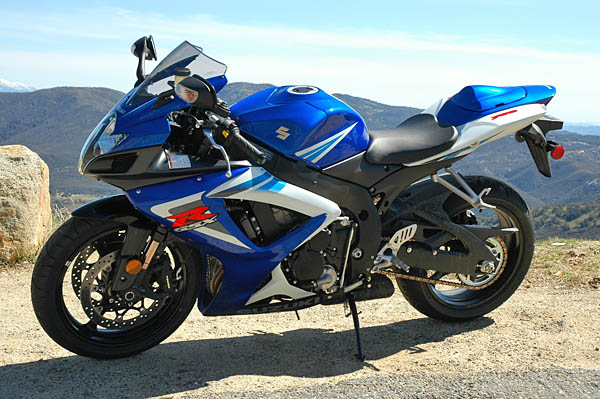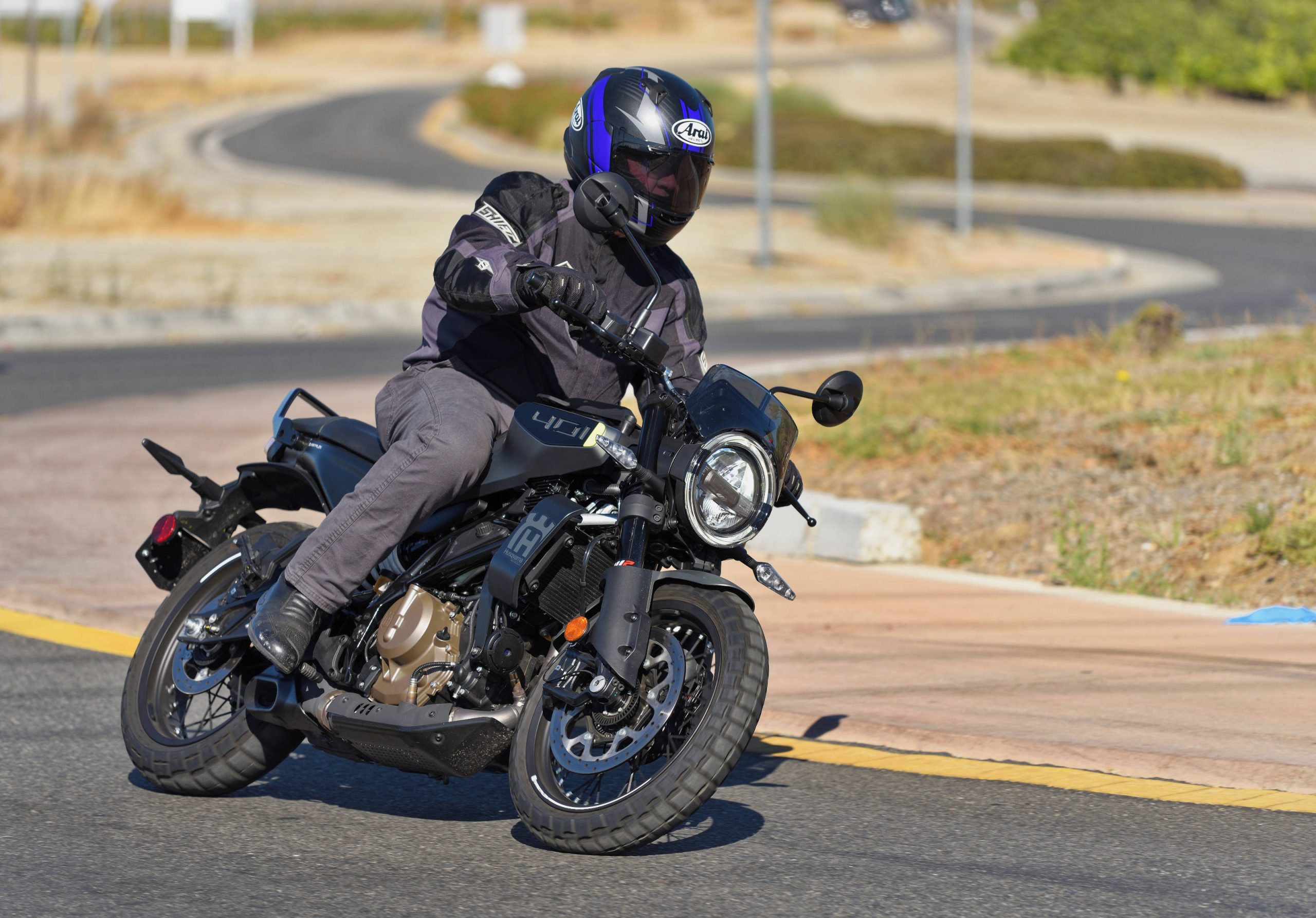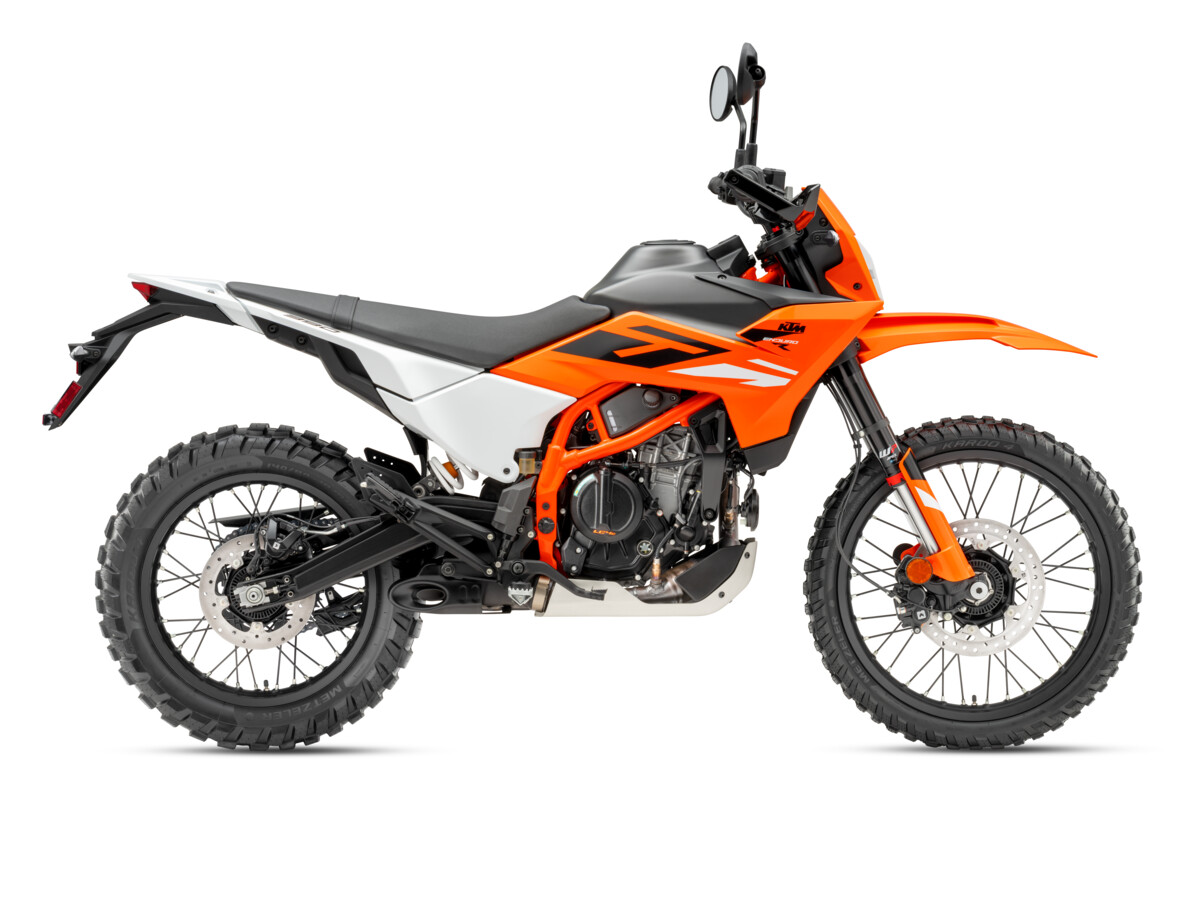
A few weeks ago, when we posted our short ‘First Street Ride’ impression of our 2006 GSX-R750, we promised to deliver a more extensive ride review soon. Judging from the number of email we received from readers demanding that we hurry up and post it, many of you have been eagerly awaiting our more in-depth commentary. Well, the wait is over: here is our full review of the 2006 GSX-R750, Suzuki’s do-it-all middleweight sportbike. Let’s start with the heart of the matter – the redesigned engine.
Despite the less oversquare dimensions (the ’06 motor is 70mm x 48.7mm vs. 72mm x 46mm for the ’05) the engine revs quickly, but has enough flywheel effect to keep itself from being too sensitive to throttle inputs. Larger crankcase holes between cylinders (39mm vs. 35mm) further reduce pumping losses of the rising and falling pistons. The cylinder head was redesigned as well. The exhaust valves are 1mm smaller and included valve angle is now 22.5 degrees, versus the 05’s 25 degrees. This has boosted compression slightly, up to 12.5:1 from 12.3:1. Overall dimensions of the engine illustrate how much the powerplant has shrunk. Height is 34mm shorter, 57mm shorter front to back and 16mm narrower. Redline is 600 rpm higher in spite of the longer stroke.
The new engine is a really well performing piece. It has just the right amount of power when you want it. It is all things to all people; you can putt around town below 5000 rpm to maintain stealth, both in terms of speed and sound. There’s enough torque available there to keep you from feverishly toeing the shift lever.
When you want more acceleration, just hold the gear a little longer and open the throttle a little more to get into the 6k – 9k range. If you’re really in a hurry, or on the track, then move the tach needle past the 10k mark. Once past that, another level of acceleration takes over. It’s not a major jump in power, but it is definitely noticeable, and it will make the liter bikes take notice. If you don’t shift your weight over the gas tank in the first two gears, the front wheel loses touch with the asphalt.
Although, the engine is strong, and provides fierce acceleration, I can’t help but feel it is working through some excessively tall gearing. First gear takes you to 85 mph, and sixth is good for a theoretical 195 mph, although the engine does not have the power to push the bike through the air at that speed. Adding three or so teeth to the rear sprocket would raise rpm by about 500 for a given speed in sixth gear, giving better acceleration without making the engine buzzy at street speeds, and may even work better at some tracks. Going down one tooth on the front sprocket is a more cost effective route, but is actually harder on the chain, as it has to go around a smaller diameter.

The transmission shifts very well, but hasn’t quite reached typical Suzuki gearbox proficiency yet, as only 1500 miles have been clocked. Daily mileage brings improved performance, however. The slipper clutch has not yet been sampled, as only street miles have been accumulated to date. The clutch itself performed transparently – that is, it did nothing to call attention to itself. Reversing the shift pattern to race spec requires placing the adjustable footpegs and shift lever in the upper / rear position – otherwise, the shift rod fouls a water pump bolt.
A counter-balancer keeps vibes in check, and the engine is quite smooth, with only a little vibration creeping in around 5k, and that’s only on deceleration.
Fueling is pretty good, but there are three noticeably different behaviors. Below 4k rpm, it feels a little ‘fluffy’ (rich). From 4k – 7k, it feels really snappy, like it’s a bit too lean. Above 8k, fueling feels spot-on. A power commander from Dynojet or EMS from Yoshimura, along with some dyno tuning, would smooth things out nicely. The throttle bodies are the same size as last year’s bike, but now feature a second set of injectors which are used in the higher rpm range. Suzuki’s dual throttle valves also remain. The throttle return spring seems a bit stiffer than those sampled on previous GSX-Rs. Fuel economy has so far ranged from 33 mpg to 48 mpg, depending on the rider’s enthusiasm and urgency.
One part of the engine hardware that seems to catch everyone’s eye is the size of the radiator. The size and trapezoid shape of the radiator never fails to elicit envious comments.
The other piece that commands attention is the exhaust. Whether MotoGP inspired or not, it is different, and effective. Small and centrally located, it moves heft much closer to the bike’s center of gravity than traditional systems, and certainly more than the now fashionable underseat exhaust systems adorning some other late model sport bikes. The catalytic converter also resides in the muffler box, so it gets quite warm, necessitating the heat shields. It is mounted aft of the servo controlled exhaust valve, so mounting a ‘slip-on’ will not eliminate the valve, which could be considered good or bad, depending on your preferences and tuning goals.
Side benefits of this design include no risk of “heated” seats for the rider or passenger, and a small space for storage under the passenger seat area. The exhaust is quite throaty, guttural even, and it combines its tones well with the trademark Suzuki induction howl, which makes a wonderful sound all its own and can cause an almost compulsive desire to repeatedly slow down and then accelerate again, just to hear the engine sing its sweet song.
Suspension this year has been thoroughly revamped. Out back, the linkage has been engineered to clear the muffler box. The Showa shock is shorter overall and features high and low-speed compression damping adjustment, as well as rebound and preload. Shock shaft and piston both have shrunk in their respective diameters, the shock stroke is 10mm shorter and overall compression damping has been increased to address complaints of being too soft on the previous model. Up front, Showa forks are 41mm in diameter, vs. the 05’s 43mm, but increased wall thickness maintains rigidity. A ‘carbonized titanium’ coating is found on the 750’s lower tubes.
The chassis also got a complete makeover to take advantage of the engine’s compact dimensions. A frame made entirely of castings is 44mm shorter, while the shorter engine measurement allows a 35mm longer swingarm. Longer axle slots are for greater range of axle (hence, wheelbase) adjustment. Rake/trail is identical to the 600, at 23.8 degrees / 97mm. Wheelbase is 1400mm (55.1 inches). Claimed dry weight is 359 lbs.
Overall, the suspension is definitely stiffer, and works well on smooth surfaces and at higher speeds. However, during typical street riding, it dishes out a rather harsh ride that no amount of adjusting from me could tune out. Only when I was riding aggressively did the overabundant compression damping begin to make sense. That’s okay for the track or committed canyon rides, but not for the rest of the riding situations I find myself in the majority of the time.

Additionally, I found that the damping adjusters only proved effective inside of their last one half turn (out from full hard) of the roughly four-turn adjustment range available. In that last little bit of adjustment, very small adjustments have a substantial effect, making finding the ideal adjustment or suitable compromise very difficult to achieve.
Handling manners of the 750 are exemplary, providing both stability and quick turning characteristics. Transitions from side to side happen without much effort, but could stand to be sped up a little, which I did with various thickness shims placed between the shock and its top mounting point. Doing this raised rear ride height, placing more weight on the front end, which increased turn-in speed and provided more and better feedback from the front end. With the standard exhaust in place, you have roughly an 8mm range of height adjustment available before the linkage contacts the muffler box, which translates into 17.76mm at the axle.
Brakes are updated as well. Rotor diameter has grown from 300mm to 310mm, and the new rotors are gripped by radial mounted calipers. A radial master cylinder delivers the hydraulic pressure. Braking action is sublime, providing not as much initial bite as some setups, but giving great feel and overall power. This means that when you squeeze the brake lever during a spirited ride, track day, or in an emergency situation, overpowering initial bite or a lack of feel will not be what puts you on your head (hopefully you won’t end up on your head at all!). I came to this realization after overcooking a couple of corners on a downhill section of a road local to me. Coming into the corner too hot, I was forced to use the front brake aggressively while the bike was leaned over fairly far. I gave the lever a pretty good squeeze, and the 750 scrubbed speed without locking the front wheel or causing me to lowside. Part of the credit for that outcome must go to the excellent Bridgestone BT-014 tires fitted as standard equipment. They give excellent traction, feedback and seem to wear very well. Despite the braking system’s already excellent performance, I do plan to experiment with other brake pad compounds.
Ergonomics proved very comfortable, with a range of footpeg adjustment of 14mm in the vertical and horizontal axis, giving the rider some flexibility to choose according to riding environment and/or rider dimensions. This new adjustability eliminates my primary complaint with previous GSX-R750s, that being the cramped seat-to-peg relationship. It’s a simple solution, and very effective in aiding rider comfort and control.
Suzuki’s seats have traditionally been very comfortable. The seat on the 750 continues this trend, but seems to be a little thinner than before, feeling as though it is nearly bottomed out after longer rides. The reach to the handlebar is fairly short, and the bars are well angled.
Instrumentation is clear and informative, with an added gear indicator which is more useful than you might first believe. A programmable shift light is reduced to novelty status because of its location at the bottom of the instrument cluster, rather than being placed at the top. A reserve fuel trip meter activates automatically, to track how many miles you have traveled since the fuel light came on (after using 3.4 gal.), although you must manually change the display mode to see it. After filling up (4.4 gal capacity), the trip meter rights itself.
At night, the instruments are lit up in a very “eighties” orange. It looks cool, but I’d prefer a light to medium blue, which is a less intense color contrast, and would make the instruments more easily readable. Headlight performance is better than the pseudo-endurance racer one-headlight look of some other sport bikes.
Wind protection is very good by sportbike standards, with the windscreen actually deflecting wind to above chest-level, which I find somewhat surprising, given the mostly ineffective examples found on many other current sportbikes.
The front half of the gas tank, which is plastic and appears to be detachable for air cleaner access independent of the fuel tank, created some false hope. The fuel tank still must be raised to remove the airbox cover for air filter servicing.
The bottom line is, after living with the new GSX-R750 for about a month, it is hard to fault its compromise between a liter bike and a 600, at least for street riding. Suzuki seems to have combined the best characteristics of both classes, while eliminating many of the drawbacks. Not to be satisfied with merely creating the perfect middleweight, they even threw in some innovative extras (like the cool-looking exhaust, and the adjustable footrest positioning) to further entice prospective buyers. If you’re looking for a machine that combines the handling prowess of a 600 with the ‘who cares what gear you’re in’ usable midrange power of a 1000 (and who isn’t?), the GSX-R750 is the bike for you.

The GSX-R750 is already on sale at your local Suzuki dealership, and carries a U.S. MSRP of $9,999. For more info and specifications, check out Suzuki’s web site.





